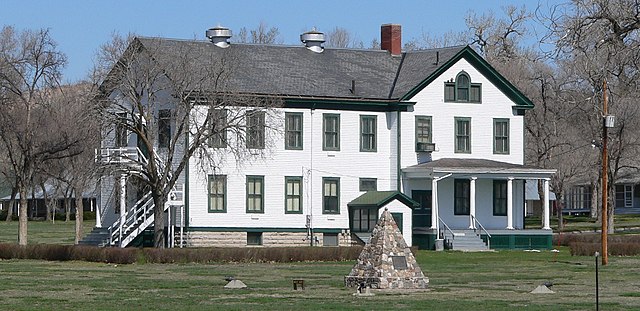Road Trip Through History: Fort Robinson
Forts and so-called “Indian agencies” and the relationship between them were a recurring them on our trip through the western plains.* The simple version is that agencies were established at various locations to manage trade and treaty obligations between the United States and the Native American nations. In theory, the agencies were intended to insure that both sides of the trade honored the rules and to negotiate disputes between them. But as treaties were negotiated and reservations were established, the relationships between the agencies and those nations became, let’s just say complicated. Increasingly, forts were established nearby to protect the agencies.**
For the most part, our experience of Indian agencies and forts was limited to historical markers. Most of the historical sites we passed were well off our path, and the sheer distances we were traveling each day meant we were less inclined to wander off the trail than we have been on previous trips. But Fort Robinson State Park was right on the way to our next planned stop.
Fort Robinson was an active military post for 74 years, from 1874 to 1948. Today, it is surrounded by a 22,000 acre state park. My guess is that for many park guests, the historical museum located in the 1905 military post headquarters is something to do on a rainy day or when people are worn out from too much outdoor fun. There certainly weren’t many people there during our visit. (In all fairness, we got there about an hour before the museum closed.)
The post was established in 1874 to “protect” the Red Cloud Agency. It was named after Lieutenant Levi Robinson who was killed by Native Americans from the Red Cloud Agency*** and played a critical role in government strategy in the Sioux Wars of 1876-1880.*** With the arrival of the railroad in the mid-1880s, which made it possible to move soldiers quickly as needed, Fort Robinson became the most important military post in the region, with its soldiers involved in the Cheyenne Outbreak, the Fort Robinson massacre (one guess as to who was massacred), the death of Crazy Horse, the rise of the Ghost Dance movement, and the tragic events at Wounded Knee. The fort served as cavalry re-mount station in World War I and as a K-9 dog training center and camp for German POWs in World War II.
Here are two of the tidbits that caught my imagination:
- The second and third Black graduates from West Point served as lieutenants with the 9th Cavalry, one of two all-Black cavalry regiments (known as buffalo soldiers) that were stationed at Fort Robinson in 1885. For the most part, they were involved in support services, like repairing telegraph lines. But the 9th Cavalry was given the job of monitoring the Ghost Dance movement and the 10th Cavalry was sent on a long winter march to rescue the all-white 7th Cavalry from Drexel Mission, where it was trapped after the Battle of Wounded Knee.
- The official K-9 corps was a new development in World War II. People were asked to donate their dogs to serve in the K-9 corps. (Personally, I cannot imagine donating a family pet for military service. It seems like a horrible betrayal.) Almost 18,000 dogs arrived at the various training centers; about 8,000 failed the physical and mental assessment. (Roughly 30% of their human counterparts also were disqualified as physically or mentally unfit.)
All told, an excellent way to spend an afternoon.
*Every time I type that I hear “Out of the clear blue of the western sky, comes Skyyyyy Kiiiing” in the back of my head. Which I realizes dates me. Though not as much as you might think. I only knew the show as a re-run in the late afternoon dead spot after day-time television and before the evening news. It was clearly dated at the time and I loved it.
** Neither the museum exhibits or any of the sources I consulted on Fort Robinson in particular or the Indian agencies in general addressed the question of who was being protected from what. Which leads me right back to the questions of who tells the story of the United States’ westward expansion, how they tell it, and what assumptions they begin from. (And by they, I mean all of us.) As I write these posts, I am almost painfully aware of how seldom this is addressed in even the best exhibits. And how easy it is to let my mind slide over its absence.
***Which tells us something about point of view.
**** Which should probably be called the Lakota Wars—this period of western history is a verbal landmine for anyone who is relatively new to the details and trying to be conscious of colonialism in her language.
Travelers’ tip: Several of the buildings that served as quarters for soldiers and officers stationed at the fort have been converted to lodging for guests to the park. If we had known that ahead of time, we might have tried to spend the night.





